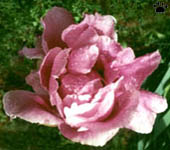
Amur peony (Paeonia obovata), Ussuriland.
Chukotka - part 9. South of Chukotka
South from Chukotka is the Kamchatka Peninsula, mostly known
for its active volcanoes. Its tundras, birch forests,
rocky coasts and the isolated area of conifers in the central valley are a wildlife
paradise. Here the world's largest brown bears and sea-eagles live. In recent
years, gold mining became the main treat to peninsular ecosystems, as river pollution
threatens Kamchatka's salmon populations - critical food source for the wildlife.
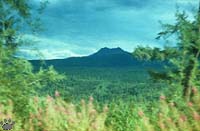
View of Ichinsky Volcano from the Central
Valley. Atlasovo, Kamchatka. |
The Central Valley of Kamchatka is an island of boreal forest, made up by endemic varieties of Ayan spruce (Picea ezonensis)
and Dahurian larch (Larix gmelini). Many species of forest plants and animals
are represented by local subspecies there. Unfortunately, these unique forests
have been almost completely logged, so now all you can see outside nature reserves is young secondary forest.. |
| Northern Kamchatka is almost never visited by tourists.
Native population is small, so the vast tundras and mountains are more or less
untouched by civilization. In summer, you can travel here for weeks, feeding
on mushrooms, berries, and salmon, and never seeing people. Parapolski Dol depression
in Northern Kamchatka is an important stopover site for migrating birds. |

King boletus (Boletus edulis) is an important
food source for native people and wildlife.
Kazarka Lagoon, Kamchatka. |

Kingberry (Rubus regius), Uzon Caldera, Kamchatka |
Uzon Caldera, Geyser
Valley and other volcanic areas of the Russian Far East may contain even more
unique and diverse microflora than Yellowstone, but most of them have never been studied
using modern methods of microorganism detection. Hot lakes and lush vegetation
around them attract wildlife, from endemic insects to bears and wintering whooper
swans (Cygnus cygnus). |
| Upstream from Geyser Valley is a
grim place called Valley of Death. Carbon dioxide seeps from the soil there, forming
a dense layer on the ground. This toxic layer can be up to 60 cm (2') thick
in predawn hours. Every spring, reserve rangers try to get to this place
and remove dead animals (mostly bears and wolverines), so that their corpses do
not attract other scavengers to the deadly trap. |
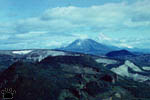
Valley of Death, Kamchatka. |
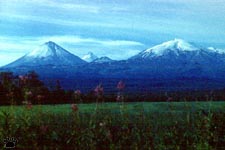
Tolbachik (right) and Klyuchevskoi (left) volcanoes. |
Klyuchevskaya Group of Volcanoes is one
of the most impressive volcanic landscapes in the world. Constant volcanic activity
created eleven beautiful stratovolcanoes, surrounded by lava fields and dust deserts.
In 1988 I found breeding common nightjars (Caprimulgus europaeus) in these
lava deserts, a few thousand miles from their previously known breeding range. |
| Klyuchevskaya Sopka, the tallest of Kamchatka's volcanoes,
is rapidly growing, and currently rises to 5800 m (17,000') almost from the sea
level. It is also one of the most beautiful peaks in the area, although Kronotsky
Volcano has even more perfect shape. |
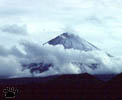
|
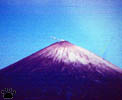
Klyuchevskaya Sopka |
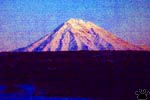
Koryaksky Volcano at sunset. |

Kronotsky Lake and Volcano. |
Altogether, there are about 500 volcanoes in Kamchatka,
and 50-60 of them are still active or dormant. Their slopes are inhabited by ptarmigans,
snow sheep and marmots (Marmota camtschatica). |
| Southern Kamchatka is mostly uninhabited. It is a
land of world's heaviest snow cover (25-30 m/80-100' on average), deep canyons,
and the world's largest salmon run at Kurilskoe Lake, which attracts hundreds
of brown bears. |
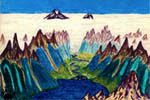
Volchy (Wolf) Fjord,
Southeastern Kamchatka. |

Kurilskoe Lake and Kambalny
Volcano, Kamchatka. |

Boarding a ship
to Kamchatka, Bering I. |
East from Kamchatka is the Russian part of the Aleutian Islands - the Commander
Islands, always wrapped in sea fog. They
were so difficult to find in the sea that the Aleuts had never discovered them until Bering's
expedition found them by chance. Even now, getting there can be a problem because
of the weather. There is only one village on
the islands, inhabited by Russians and Aleuts - descendants of Russian-American
Company employees, who were brought there in the 18th century to hunt fur seals and sea otters. |
| The endemic species - Steller's sea cow (Hydrodamalis
gigas), and flightless cormorant (Phalacrocorax stelleri) are long
extinct, but the islands still have some of world's largest fur seal rookeries, seabird
colonies, and kelp forests. Three species of rare Aethia auklets breed
here. |

Red-legged kittiwakes (Rissa
brevirostris), one of the species of
American origin on the Islands. |

Glaucous-winged gull
(L.glaucescens) here nests
only at fur seal rookeries. |

Snowy owl protecting its nest,
Medny Island, Russia |
The Commander Islands are a good place to see some rare seabirds
and cetaceans. Each of the two larger islands has
its own subspecies of Arctic fox, and in upland
areas there are isolated populations of some tundra species, such as snowy owl
(Bubo scandiacus). |
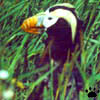 |  | 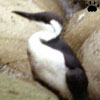 | 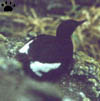 |  | | Common colonial seabirds of Commander Islands, left to right: tufted puffin (Fratercula cirrhata), horned puffin (F. corniculata), common murre (Uria aalge), pigeon guillemot (Cepphus columba), red-faced cormorant (Phalacrocorax urile). |
| The most spectacular, diverse and understudied
part of RFE are the Kuril Islands - a volcanic chain between Kamchatka
and Japan. Northern islands are covered with alder and pine shrub; moving south,
you pass through tundra, coastal meadows, birch parklands, dense conifers and
subtropical rainforests. World's largest and most diverse seabird colonies can
be seen in the central part of the island chain. |
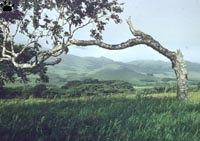
Birch parklands, Iturup I. |
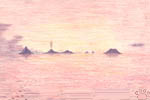
Morning off Matua I.,Middle Kuril Is. | Kuril Islands are currently almost uninhabited. The southern part is claimed by Japan, and there are plans for full-scale colonization and commercial development. Marine and terrestrial ecosystems, especially unique marine invertebrates and mammals, are under serious treat. |
| The Kuril Islands are one of the most beautiful parts of our
planet, their natural wonders could be a great tourist attraction. The best way to settle the claim would be to establish a Russian-Japanese Nature reserve on the islands. There are a few existing
reserves in the area, but they can't efficiently protect it from mining and overfishing. |
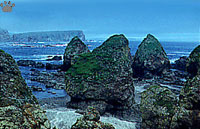
End of The World Cape, Shikotan I.
|

Lava formations at Cape Stolbchaty, Kunashir I.
(Hokkaido I., Japan,
is visible on the horizon) |
But if they
were openly or secretly sold to Japan by the corrupt Russian government, they'd be soon
covered by golf courses, paved highways, and canning factories. The first projects
had already emerged and had been discussed by local authorities even before most
of the population left the islands following a tsunami in 1994. |

Lava formations at Cape Stolbchaty | 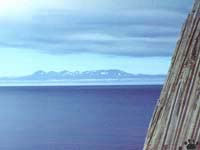
View of Shiretoko Peninsula, Japan, from Cape Stolbchaty |
| Under the Japanese ownership of the islands in 1904-1945, native
Ainu people were killed or deported. Most seal rookeries,
sea otter and whale populations were depleted, and forests loggeed. It took local ecosystems half a century to recover. Some species, such as the endemic race
of sika deer (Cervus nippon kurilensis) became extinct; others, such as
sea otters, have only survived in the northern part of the island chain. |
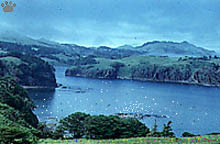
Unnamed cove, Shikotan, Russia
|
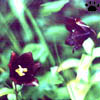 | 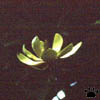 | 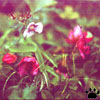 | 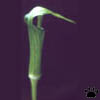 |
| Flowers of the Kuril Islands,
left to right: Fritillaria kamtschatica, Magnolia obovata, Rhododendron kamchaticum,
Arisaema japonica |
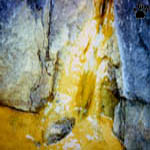
Golden Waterfall owes its color to an
undiscribed algae species. Kunashir. |

Fumaroles at Mendeleev
Volcano, Kunashir. |
Shikotan Island and the southern part of Kunashir have particularly
high biodiversity. Many species of plants are common on the islands, but
rare or endangered elsewhere. Hot springs and lakes
shelter a world of heat-adapted organisms which nobody has ever studied. |
| Among the rare birds of Kunashir and Shikotan are red-crowned
crane (Grus japonicus), Blakiston's fishing owl (B. blakistoni),
two sea eagles (Haliaeetus), and mountain hawk-eagle (Spizaetus nipalensis),
which nests on the rocky summit of Mendeleev Volcano. Unfortunately, these two islands
will probably be the first to be re-colonized and intensely developed by the Japanese. |
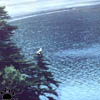
White-tailed sea eagle,
Shikotan. |
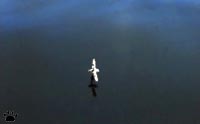
Northern fulmar (Fulmarus glacialis), off Iturup I. |
Marine ecosystems will be probably hit even worse than
terrestrial ones. Beaches around the four remaining villages on
the southern Kurils are lined with fishing and whaling boats confiscated from Japanese
poachers, who daily cross the border looking for fish, sea urchin, crab, dolphins,
whales and seaweed. |
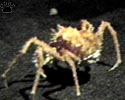 | 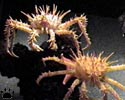 | 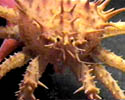 | 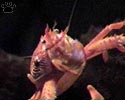 | | King crabs (Paralithodes) and related species are highly prized and mercilessly harvested throughout the North Pacific. |
| The day the border will be opened, the massacre will begin full-scale.
Japanese opinion on whaling is well known, there is little doubt that these activities
will not be stopped by the government soon enough. Estimates suggest that
it will take 2-3 years to do an irreversible damage to marine and forest ecosystems,
and that in 5-10 years almost all rare and endangered species will be wiped out. |

Hardwood forest with dwarf bamboo
(Susa) in the undergrowth, Kunashir. |
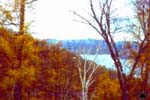
Larch taiga, Zeya River, Russia. |
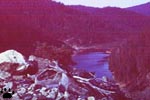
Fir taiga, Amut Lake, Russia. |
Amur is the largest river of RFE. Its valley is mostly developed, but some fine forests and wetlands
still exist. The river itself is home to over 200 fish species, some of them very
impressive. |
| Rare and endemic birds of the area include Siberian grouse (Dendragapus falcipennis), Baer's porchard (Aethya baeri), oriental stork (Ciconia boyciana), swan goose (Anser cygnoides), scaly-sided merganser (Mergus squamatus), Swinhoe's rail (Coturnicops exquisitus), Japanese waxwing (Bombycilla japonica), and many others. Some birds are common here, but rare in other parts of their range, such as smew (Mergus albellus), azure tit (Parus cyanus), and Eurasian eagle owl (Bubo bubo). |
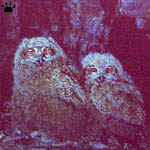
Eagle owls, Bureya River, Russia. |

Red-crowned
crane,
Khanka Lake. | 
Hooded crane,
near Evoron
Lake. |
Five species
of cranes breed in Amur Basin. Demoiselle (Grus virgo)
and common (G. grus) cranes are widespread, but others are mostly endemic
to the area. Red-crowned (G. japonicus), white-naped (G. vipio), and hooded (G. monachus)
cranes can be easily seen on their wintering grounds in Japan, but it is much
more interesting and challenging to look for them during the breeding season. |
| Ussuriland, the southernmost part of the
Russian Far East, has especially diverse flora and fauna, with a strange mixture
of Siberian and Oriental species and a lot of endemics. Here the ecosystems face
numerous problems, such as rapidly growing Chinese immigration. Within a decade (1990-2000),
local populations of snakes, medicinal plants, musk deer (Moschus moschiferus)
and bears (Ursus arctos, U. tibetanus) have collapsed. Now many species
are caught and smuggled out of the country for pet and souvenir trade. International
organizations try to help protect some species, but they mostly care about
large animals, such as tigers or cranes. Overcollecting of rare insects of Ussurilandis also a problem. Among the birds suffering from illegal pet trade are robins (Luscinia),
redstarts (Phoenicurus), buntings (Emberiza), rock-thrushes (Monticola),
various finches and flycatchers. |
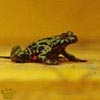
Firebelly toad Bombina
orientalis, Russia's most
beautiful frog, is now
common only in
Western pet stores. | 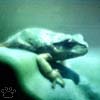
Tree frog Hyla orientalis,
another victim of pet trade. |

Asian brown flycatcher
(Muscicapa dauurica),
Lazo, Ussuriland. |
There are 420-450 species of birds in Ussuriland (nobody knows
for sure). Here you can see red-crowned, white-necked and hooded cranes in spring;
minivets, buttonquails and paradise-flycatchers in summer; lots of Arctic migrants
in the fall; Steller's sea eagles and great bustards in winter; scaled mergansers
and Blakiston's fish-owls year-round. Unfortunately, many species are endangered
or already extinct. In 1986, I happened to be the last person to see
rufous-backed bunting (Emberiza jankowskii) in Russia. Some birds of this
beautiful species still survive in China, but their numbers decline there as well. |
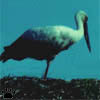 | 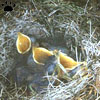 | 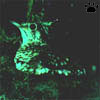 | 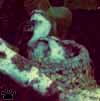 | 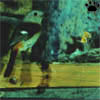 | | Nests of some birds of Amur and Ussuri valleys, left to right: Oriental stork (Ciconia boyciana), orange-flanked robin (Luscinia cyanurus), scaly thrush (Zoothera dauma), ashy minivet (Pericrocotus divaricatus), Daurian redstart(Phoenicurus auroreus). |
| For many years, the main concern of environmentalists in Ussuriland
was habitat loss in the beautiful forests
of the area, particularly in mixed forest zone. Korean pine (Pinus koraensis),
locally known as "cedar", was logged despite its importance as food
source for wildlife. Now most old-growth forests outside nature reserves have
been lost. Another problem is agricultural development in grasslands, wetlands,
meadows and woodlands of Southern Ussuriland. For many East Asian plants and animals,
this is the northernmost part of their range. There are also some endemics there,
such as reed parrotbill (Paradoxornis heudei). |
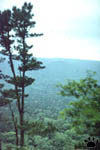
Korean pine, Ussuriland |
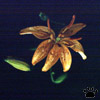 |  |  |  |  |  | | Flowers of Southern Ussuriland, left to right:
Lilium distichum, Hemerocallis thunbergi, Lihnis splendens, Platanthera orientalis,
H. minor, Hypericum shrenkii. |
|
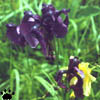 | 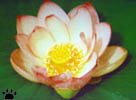 | 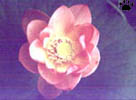 | 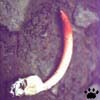 | | Plants and mushrooms of Southern Ussuriland, left to right: Iris chrysonrarches, Lotus nuciferum var. komarovi (2 photos), Mutinus raveneli. |

Steller's sea eagle
(Haliaetus pelagicus),
Kamchatka River
Narrows, Kamchatka. |

Sus scrofa ussuriensis,
world's largest subspecies
of wild boar, Kedrovaya
Pad', Ussuriland |
As the regional economy is slowly making it out of decline, environmental situation is steadily worsening. River valleys are destroyed first because of their accessibility, so riparian birds and other animals are the largest group of endangered species. |
|
 |  |  |  | | Snakes of Ussuriland, left to right: Elaphe asiatica, E. schrenkii, clutch of Amphiesma japonica, Agkistrodon blomhoffi (rare red phase). |
| Meanwhile, local birds try to adapt to changing conditions and new habitats.
Some are successful, but many species are in decline. Ten species are already
extinct in the region, and more than a hundred are endangered. The next 20-30
years will be the most difficult time for the nature of the Far East - let's hope
it will survive. |
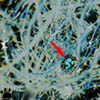
Nest of snow bunting
(Plectophenax nivalis)
in a pile of barbed wire,
Vrangel I., Russia | 
Nest of carrion crow
(Corvus corone), made
of electric cables,
Vladivostok, Russia. | 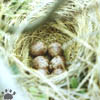
Nest of Japanese skylark
(Alauda japonica)
in a haystack,
Sakhalin I., Russia. |

View from Klyuchevskaya Sopka, Kamchatka.
Back to Part 8
Home
|








































































